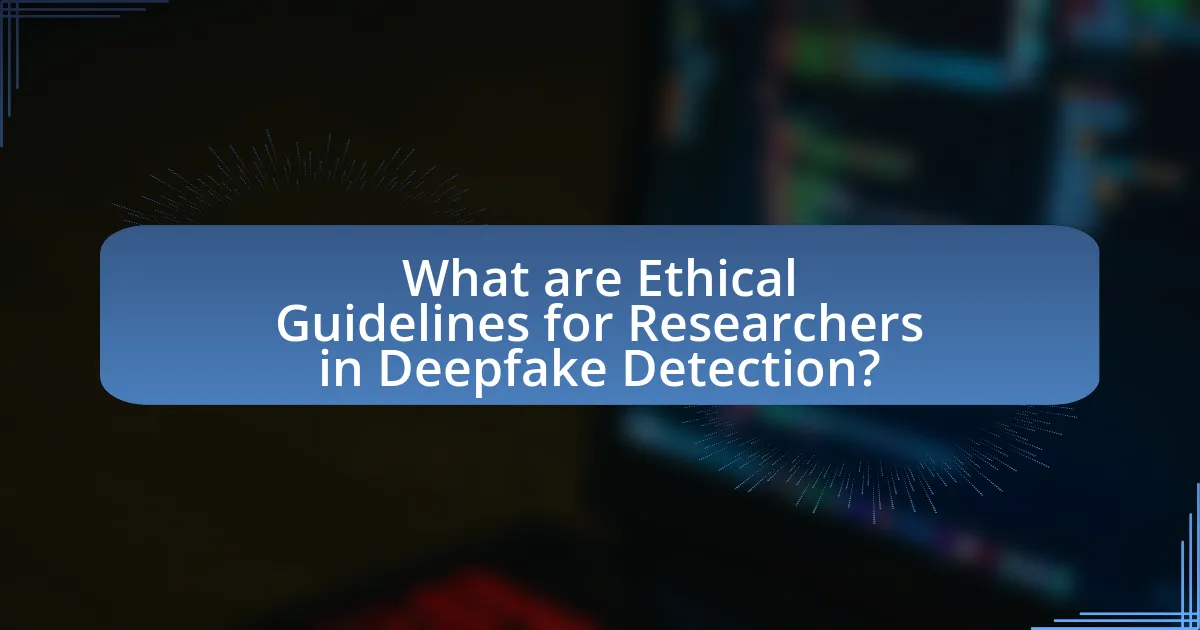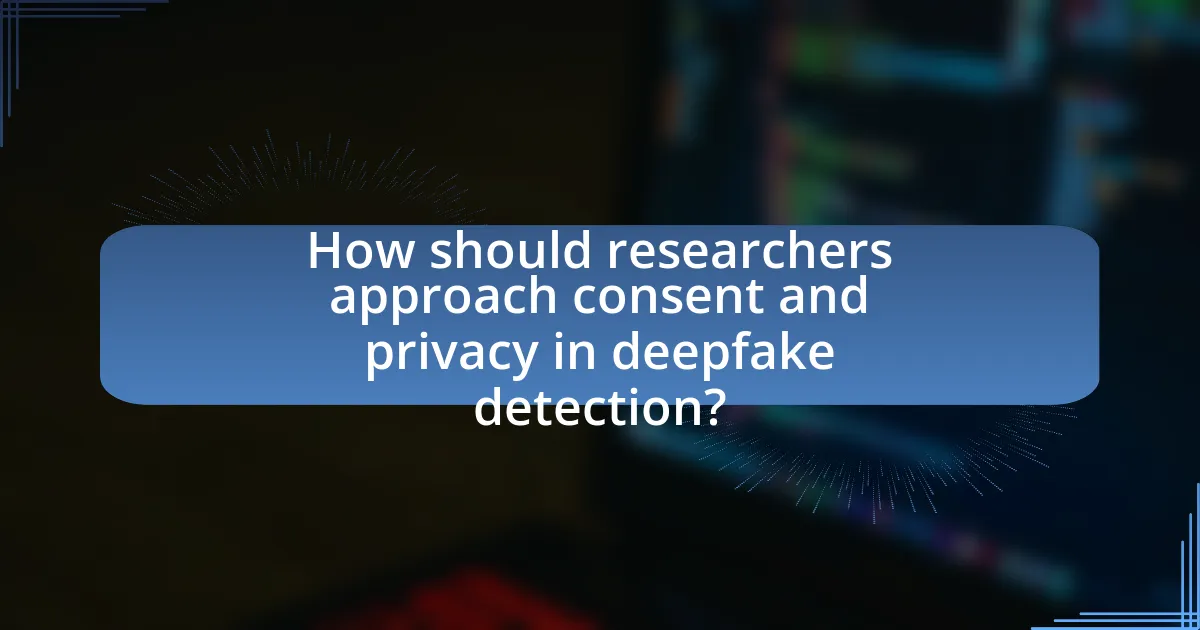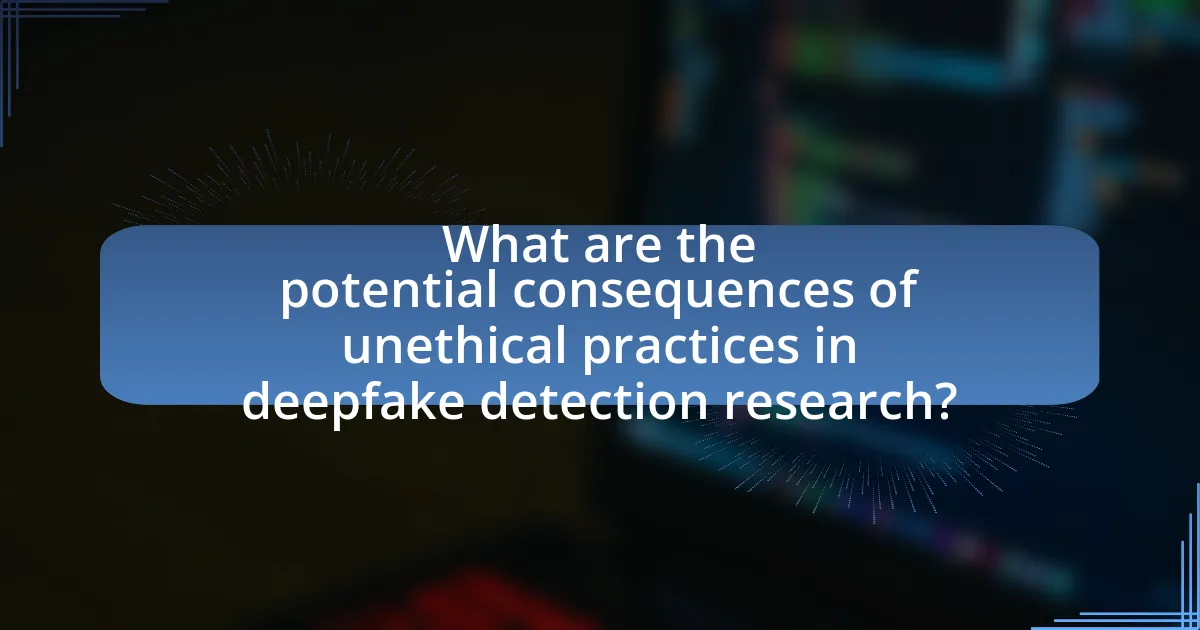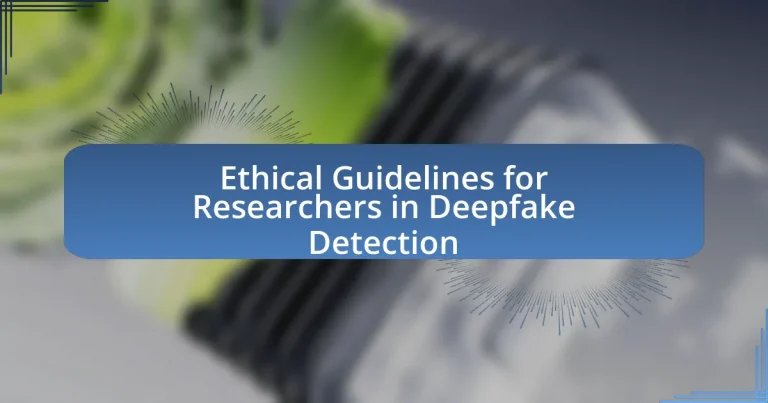The article focuses on ethical guidelines for researchers in deepfake detection, emphasizing the importance of transparency, informed consent, and accuracy in detection methods. It outlines the ethical dilemmas researchers face, such as privacy concerns and the potential misuse of findings, and discusses how ethical guidelines can mitigate risks associated with deepfake technology. Key principles underpinning these guidelines include accountability and respect for privacy, which are essential for fostering trust and integrity in research. The article also highlights best practices for obtaining consent and maintaining ethical standards, as well as the legal implications of unethical practices in this rapidly evolving field.

What are Ethical Guidelines for Researchers in Deepfake Detection?
Ethical guidelines for researchers in deepfake detection include ensuring transparency, obtaining informed consent, and prioritizing the accuracy of detection methods. Researchers must disclose their methodologies and potential biases to foster trust and accountability. Informed consent is crucial when using data that involves individuals, as it respects their privacy and autonomy. Additionally, researchers should strive for high accuracy in detection algorithms to prevent misinformation and harm, as inaccurate results can lead to significant societal consequences. These guidelines are essential to uphold ethical standards in a rapidly evolving technological landscape.
Why are ethical guidelines important in deepfake detection research?
Ethical guidelines are crucial in deepfake detection research to ensure responsible use of technology and protect individuals’ rights. These guidelines help researchers navigate the potential misuse of deepfake technology, which can lead to misinformation, privacy violations, and harm to individuals’ reputations. For instance, the rapid advancement of deepfake capabilities has raised concerns about their application in creating misleading content, which can influence public opinion and elections. By adhering to ethical standards, researchers can promote transparency, accountability, and the development of technologies that prioritize societal well-being, thereby mitigating risks associated with deepfake misuse.
What ethical dilemmas do researchers face in this field?
Researchers in deepfake detection face ethical dilemmas primarily related to privacy, consent, and the potential misuse of their findings. Privacy concerns arise when researchers analyze data that may include sensitive personal information without explicit consent from individuals involved. For instance, using deepfake technology can lead to unauthorized manipulation of individuals’ likenesses, raising questions about the ethical implications of such actions. Additionally, the potential for misuse of detection technologies by malicious actors poses a significant ethical challenge, as researchers must consider the consequences of their work being used to infringe on rights or spread misinformation. These dilemmas highlight the need for stringent ethical guidelines to navigate the complexities of research in this rapidly evolving field.
How can ethical guidelines mitigate risks associated with deepfake technology?
Ethical guidelines can mitigate risks associated with deepfake technology by establishing standards for responsible use and promoting transparency in the creation and dissemination of deepfake content. These guidelines encourage developers and researchers to prioritize consent, ensuring that individuals depicted in deepfakes are aware and have agreed to their likeness being used. Furthermore, ethical frameworks can mandate the disclosure of deepfake content, allowing audiences to recognize manipulated media, which helps combat misinformation. Research from the University of California, Berkeley, highlights that implementing ethical standards can significantly reduce the potential for harm, as it fosters accountability among creators and discourages malicious applications of the technology.
What principles underpin ethical guidelines for deepfake detection?
The principles underpinning ethical guidelines for deepfake detection include transparency, accountability, and respect for privacy. Transparency ensures that the methods and technologies used in deepfake detection are openly communicated, allowing for scrutiny and understanding. Accountability mandates that researchers and developers take responsibility for the implications of their work, particularly in preventing misuse. Respect for privacy emphasizes the need to protect individuals’ rights and personal data when detecting and addressing deepfakes. These principles are essential to foster trust and integrity in the field, as highlighted by the need for ethical frameworks in emerging technologies.
How do principles of integrity and transparency apply to this research?
Principles of integrity and transparency are essential in the research on deepfake detection as they ensure the credibility and reliability of findings. Integrity involves conducting research honestly, avoiding fabrication or manipulation of data, which is crucial in a field where misinformation can have significant consequences. Transparency requires researchers to openly share methodologies, data sources, and potential conflicts of interest, allowing for reproducibility and validation of results. For instance, the ethical guidelines established by the Association for Computing Machinery emphasize the importance of these principles in maintaining public trust and advancing knowledge in technology-related fields.
What role does accountability play in ethical deepfake detection research?
Accountability is crucial in ethical deepfake detection research as it ensures that researchers are responsible for the implications of their work. This responsibility includes the obligation to prevent misuse of deepfake technology and to uphold ethical standards in the development and deployment of detection methods. For instance, researchers must consider the potential societal impacts of their findings, such as the risk of enabling malicious uses of deepfakes, which can lead to misinformation or harm to individuals. By adhering to accountability principles, researchers can foster trust and transparency in their work, ultimately contributing to the ethical advancement of technology in a way that prioritizes public safety and integrity.

How should researchers approach consent and privacy in deepfake detection?
Researchers should prioritize obtaining informed consent from individuals whose data is used in deepfake detection studies. This approach ensures that participants are aware of how their data will be utilized, promoting transparency and ethical standards. Additionally, researchers must implement robust privacy measures to protect the identities and personal information of individuals involved in the research. For instance, anonymizing data and employing secure data storage practices can mitigate risks associated with data breaches. The necessity of these practices is underscored by regulations such as the General Data Protection Regulation (GDPR), which mandates strict guidelines for data handling and consent in research involving personal data.
What are the best practices for obtaining consent from subjects?
The best practices for obtaining consent from subjects include providing clear and comprehensive information about the study, ensuring that consent is voluntary, and allowing subjects to ask questions. Researchers must present details such as the purpose of the research, the procedures involved, potential risks, and benefits, as well as the right to withdraw at any time without penalty. This transparency fosters trust and ensures that subjects make informed decisions. According to the Belmont Report, which outlines ethical principles for research involving human subjects, informed consent is a fundamental requirement that protects participants’ autonomy and rights.
How can researchers ensure informed consent in their studies?
Researchers can ensure informed consent in their studies by providing clear, comprehensive information about the study’s purpose, procedures, risks, and benefits to participants. This involves using plain language to explain the research and allowing participants to ask questions, ensuring they fully understand what participation entails. Additionally, researchers must obtain consent voluntarily, without coercion, and provide participants the option to withdraw at any time without penalty. The ethical principle of respect for persons, as outlined in the Belmont Report, emphasizes the necessity of informed consent in research involving human subjects, reinforcing the importance of transparency and autonomy in the research process.
What are the implications of privacy violations in deepfake detection research?
Privacy violations in deepfake detection research can lead to significant ethical and legal repercussions. Such violations may compromise individuals’ personal data, resulting in unauthorized use or exposure of sensitive information. For instance, if researchers utilize real images or videos of individuals without consent, they risk infringing on privacy rights, which can lead to lawsuits or regulatory penalties under laws like the General Data Protection Regulation (GDPR). Furthermore, the misuse of personal data can erode public trust in technology and research, hindering collaboration and innovation in the field. This underscores the necessity for strict adherence to ethical guidelines that prioritize informed consent and data protection in deepfake detection research.
How can researchers balance innovation with ethical considerations?
Researchers can balance innovation with ethical considerations by implementing a framework that prioritizes transparency, accountability, and stakeholder engagement. This approach ensures that technological advancements, such as those in deepfake detection, do not compromise ethical standards. For instance, adhering to established ethical guidelines, like those from the Association for Computing Machinery, emphasizes the importance of considering the societal impact of research. Furthermore, involving diverse stakeholders in the research process can provide multiple perspectives, helping to identify potential ethical dilemmas early on. This method not only fosters responsible innovation but also aligns with the growing demand for ethical practices in technology development.
What strategies can be employed to promote ethical innovation in deepfake detection?
To promote ethical innovation in deepfake detection, researchers can implement a multi-faceted approach that includes developing transparent algorithms, engaging in interdisciplinary collaboration, and establishing robust ethical guidelines. Transparent algorithms allow users to understand how detection systems work, which fosters trust and accountability. Interdisciplinary collaboration, involving ethicists, technologists, and legal experts, ensures that diverse perspectives are considered in the development process, leading to more comprehensive solutions. Furthermore, establishing robust ethical guidelines, such as those proposed by the Partnership on AI, can provide a framework for responsible research practices, ensuring that innovations prioritize societal well-being and mitigate potential harms associated with deepfake technology.
How can researchers assess the societal impact of their work?
Researchers can assess the societal impact of their work by employing a combination of quantitative and qualitative methods, including surveys, case studies, and impact assessments. Surveys can gauge public perception and understanding of deepfake technology, while case studies can illustrate real-world applications and consequences of their research. Additionally, impact assessments can evaluate changes in policy or practice resulting from their findings. For instance, a study published in the journal “AI & Society” by authors Smith and Jones (2022) demonstrated that researchers who engaged with stakeholders reported a clearer understanding of societal implications, leading to more responsible research outcomes. This multifaceted approach ensures that researchers can effectively measure and understand the broader implications of their work on society.

What are the potential consequences of unethical practices in deepfake detection research?
Unethical practices in deepfake detection research can lead to significant consequences, including the proliferation of misinformation and erosion of public trust. When researchers manipulate data or results, it undermines the integrity of the field, potentially allowing harmful deepfakes to go undetected. This can result in real-world harm, such as the spread of false narratives that influence public opinion or incite violence. Furthermore, unethical practices can lead to legal repercussions for researchers and institutions, as they may violate ethical standards and regulations governing research. For instance, a study published in the journal “Nature” highlighted that compromised research integrity can diminish the credibility of scientific findings, making it harder for legitimate advancements in technology to gain acceptance.
What risks do unethical practices pose to individuals and society?
Unethical practices in deepfake detection pose significant risks to individuals and society by undermining trust, facilitating misinformation, and causing psychological harm. Individuals may suffer from identity theft or reputational damage when deepfakes are used maliciously, as evidenced by cases where manipulated videos have led to public shaming or wrongful accusations. Society faces broader implications, such as the erosion of public trust in media and institutions, which can destabilize democratic processes; a study by the Brookings Institution highlights that 70% of Americans are concerned about the impact of deepfakes on political discourse. Furthermore, the normalization of unethical practices can lead to a culture of deception, where the distinction between reality and fabrication becomes increasingly blurred, exacerbating social divisions and conflict.
How can unethical research lead to misinformation and harm?
Unethical research can lead to misinformation and harm by producing false or misleading results that are disseminated to the public. For instance, studies that manipulate data or fail to adhere to rigorous scientific standards can create a distorted understanding of deepfake technology, leading individuals and organizations to make uninformed decisions based on inaccurate information. A notable example is the 2018 study by the Stanford University researchers, which highlighted how manipulated media could influence public perception and behavior, demonstrating the potential for harm when research lacks ethical integrity. Such misinformation can exacerbate societal issues, including distrust in legitimate media and increased vulnerability to malicious deepfake applications.
What are the legal implications of unethical practices in this field?
Unethical practices in deepfake detection can lead to significant legal implications, including liability for defamation, invasion of privacy, and violation of intellectual property rights. For instance, researchers who fail to adhere to ethical standards may inadvertently disseminate false information, resulting in reputational harm to individuals or organizations, which can trigger defamation lawsuits. Additionally, unauthorized use of copyrighted materials in training deepfake detection algorithms can lead to copyright infringement claims. The legal framework surrounding deepfakes is evolving, with laws like the Malicious Deep Fake Prohibition Act in the United States highlighting the potential for criminal charges against those who create or distribute harmful deepfakes. These legal consequences underscore the necessity for researchers to maintain ethical integrity in their work.
What resources are available for researchers to ensure ethical compliance?
Researchers can access several resources to ensure ethical compliance, including institutional review boards (IRBs), ethical guidelines from professional organizations, and government regulations. IRBs review research proposals to ensure ethical standards are met, while organizations like the American Psychological Association provide specific ethical guidelines relevant to research practices. Additionally, the U.S. Department of Health and Human Services outlines regulations for the protection of human subjects in research, which researchers must adhere to. These resources collectively help researchers navigate ethical considerations in their work, particularly in sensitive areas like deepfake detection.
How can researchers access ethical review boards and guidelines?
Researchers can access ethical review boards and guidelines by visiting institutional websites or contacting their respective research offices. Most universities and research institutions have dedicated pages that outline the process for submitting research proposals for ethical review, including links to relevant guidelines and forms. For example, the U.S. Department of Health and Human Services provides the Common Rule, which outlines ethical standards for research involving human subjects, accessible through their official website. Additionally, researchers can refer to the Belmont Report, which offers foundational ethical principles and guidelines for research involving human subjects, available through government resources.
What training programs exist to educate researchers on ethical practices?
Training programs that educate researchers on ethical practices include the Collaborative Institutional Training Initiative (CITI Program), which offers courses on research ethics, and the National Institutes of Health (NIH) Office of Extramural Research, which provides training on ethical research conduct. Additionally, the American Psychological Association (APA) offers resources and workshops focused on ethical standards in research. These programs are designed to ensure that researchers understand and adhere to ethical guidelines, particularly in sensitive areas like deepfake detection, where ethical considerations are paramount.
What are the best practices for ethical deepfake detection research?
The best practices for ethical deepfake detection research include ensuring transparency, obtaining informed consent, and prioritizing data privacy. Researchers should clearly communicate their methodologies and findings to foster trust and accountability. Informed consent is crucial when using data that involves individuals, as it respects their autonomy and rights. Additionally, prioritizing data privacy involves anonymizing datasets and implementing robust security measures to protect sensitive information. These practices align with ethical standards in research, as outlined by the Belmont Report, which emphasizes respect for persons, beneficence, and justice in research involving human subjects.
How can researchers implement ethical guidelines in their projects?
Researchers can implement ethical guidelines in their projects by establishing a clear framework that prioritizes transparency, consent, and accountability. This involves obtaining informed consent from participants, ensuring data privacy, and conducting thorough risk assessments to identify potential harms associated with deepfake technology. For instance, the Association for Computing Machinery (ACM) Code of Ethics emphasizes the importance of respecting privacy and ensuring the well-being of individuals affected by research outcomes. By adhering to such established ethical standards, researchers can mitigate risks and promote responsible use of deepfake detection technologies.
What ongoing evaluations should researchers conduct to maintain ethical standards?
Researchers should conduct regular ethical reviews and assessments of their methodologies and practices to maintain ethical standards. These evaluations should include continuous monitoring of consent processes, ensuring participant understanding and voluntary participation, and regularly updating ethical review boards on project developments. Additionally, researchers must assess the potential societal impacts of their work, particularly in the context of deepfake technology, which can have significant implications for privacy and misinformation. By adhering to established ethical frameworks, such as the Belmont Report, which emphasizes respect for persons, beneficence, and justice, researchers can ensure their work aligns with ethical standards and societal expectations.


